

This page is dedicated to the memory of the Jews of Jasienica who called it Yashnitza. It was a dairy town, and famous for its eggs. A family story explains: at my parents wedding in 1934, they determined that my grandparents were born within 10 miles of each other in "the old country", and how? Because they called the scrambled eggs, Yashnitzers!
On the right is an area map and Jasienica is located at latitude
49° 45´ longitude 21° 57´, about 10 miles North East of the major
city of Krosno (find Krosno, then go up and right). There were
many towns in Poland called Jasienica (just as in the United
States, there are many Washingtons); "ours" is named Jasienica
Rosielna today. 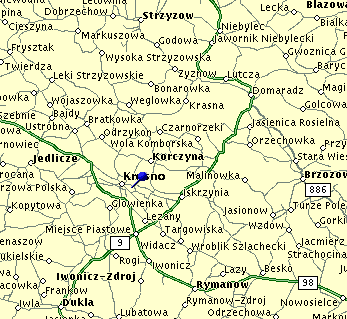
The nearest towns with Jewish populations were: Domaradz (2 miles N), Brzozow (5 miles SSE), Korczyna (6 miles WSW), Niebylec (8 miles NNW), Krosno (9miles WSW) and Strzyzow (10 miles NW).
This is important: if you are interested in the history or current status of the area, please visit our primary site the Krosno web site.
Up until 2019, Phyllis Kramer (OBM) developed and maintained this KahilaLink. Phyllis did a wonderful job documenting and sharing information about this shtetl. Starting in July 2021 Jeff Alexander is trying to fill Phyllis’ shoes. Please contact Jeff Alexander for anything related to this shtetl
Copyright © (2022) Jeffrey Alexander. All rights reserved.
Also note: This site exists because of your Generosity. Your tax deductible donation to JewishGen makes these services possible. If this site helps your search, just click on Jewish Gen-erosity.
![]() click to return to the
JewishGen Home Page
click to return to the
JewishGen Home Page

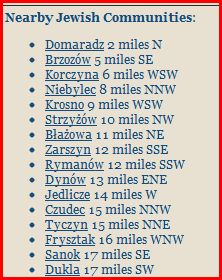
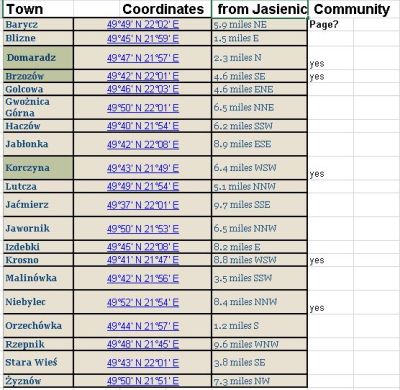
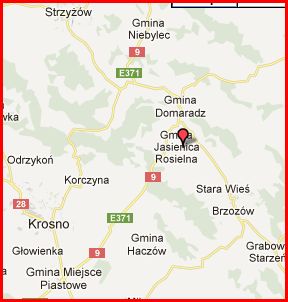

 2012
2012  2012
2012  including Yad Vashem, the USHMM, the International
Tracing Service, JewishGen’s Holocaust Database &
Global Registry, Yizkor Books, the Camps &
Ghettos, YIVO, Joint Distribution Committee and the
Jewish Historical Institute in Warsaw
including Yad Vashem, the USHMM, the International
Tracing Service, JewishGen’s Holocaust Database &
Global Registry, Yizkor Books, the Camps &
Ghettos, YIVO, Joint Distribution Committee and the
Jewish Historical Institute in Warsaw
Recently i came across the following under Demographics at this new Polish website. I used Google translate so you may see some incorrect grammar or confusing sentences. The page is at http://www.sztetl.org.pl/en/towns/j/109-jasienica-rosielna/100-demography/20894-demography and use Google Translate.
"From the Book of the birth of the municipality Israelite Jasienica Rosielna performed from 1 January 1902. August 4, 1905. Shows that at that time the world came here 175 children. Looking at individual years shows it as follows: in 1902-1950, in 1903-1946, in 1904-1952 and 1905-1927 (August 4). These data refer to the population in the district by register Jasienica Rosielna, where in 1900 Jews lived in 1118, so the birth rate ranged from 4.1 to 4.7 percent. Full of entries is 139, 26 incomplete and therefore only to the number of 165 people will relate more data. This was 76 boys and 89 girls. The birth was reported dead 8. At the age of three years died and 17 children aged 3-10 years, the next 4 were able to determine that 103 children were born out of wedlock in the compounds according to the law, because the civil law did not include religious vows. The number of children out of wedlock only 9 cases not specified the names of the fathers. The wedding was recorded 53 children. In 39 cases, the parents at a later time entered into a civil marriage.
Birth in different villages belonging to the Jewish religious community Jasienica Rosielna were as follows: Jasienica Rosielna - 56 children; Domaradz - 26; Barycz - 14; Blizne - 8; Haczów - 7; Golcowa - 4; Yablunytsia Poland - 4; Malinówka - 3; Brzezanka Jasienicka - 2; Nutcracker - 2;
"Among the fathers was 42 merchants, 32 zarobników, 5 propinatorów, 3 butchers, 2 tailors, the innkeeper, innkeeper, merchant eggs, spicy dealer, tinsmith, farmer, publican, the caretaker of the forest, the caretaker of the court, shames, the manufacturer of vinegar and baker. In the 27 cases reported livelihoods father of the child, and in 5 cases it was found that the child's father at his father, it being understood that helped them in their business. However, in 9 cases not given the names of the fathers, and therefore do not know from what is claimed. There was one case of conversion. Hene Rachwal born June 2, 1904 r. In Domaradz, passed in 1924. Catholicism. Perhaps it had to do with her ??she married a Catholic.
On the basis of records failed to determine the origin of environmental 121 marriages. Local Jews married in 51 cases of women from their villages, and in 70 they took wives from other locations. Wives come: Barycz - with Barycz 2, Dukla 2, Nowosielec 2, Niwiski and Rzeszow Blizne - with Blizne 2, Dukla, Lesko, Sanok and Zolynia Brzezanka Jasienicka - with Jurowiec Domaradz - with Barwinka, Blazo./..

This is a fabulous organization which is devoted to indexing vital records from Poland and Ukraine. There are things you can do with JRI-P:
(Polish) Miasteczko, pow. Brzozow, siedziba sadu
powiatowego, sad okr. Sanok, 2090 mieszk.........
(French) Petite ville, distr. De Brzozow, trib de distr
Brzozow, trib d'arr-t-Sanok, 2090 habit. (train) (17 km)
Iwonicz x x Jasienica k. Brzozowa, x Brzozow; 1 cath, 1
synag. Marches: le jeudi
The following is the beginning of an English
translation...I will try to improve it with time
The following trades and tradesmen were listed, first in Polish, and then in French; we have translated the trades into English. (note that only surnames were extracted; company names were omitted):
| SURNAME, FIRST NAME | TRADE (Polish) | TRADE (French) | TRADE (English) |
| Beim, J | Blawaty | Tissus | Fabrics |
| Berglas, M | Rozne Towary | Articles divers | General Store |
| Berglas, S | Rozne Towary | Articles divers | General Store |
| Berglas, S | Ubrania Gotowe | Vetements Confectionnes | Clothing Designers? |
| Blum, M | Rozne Towary | Articles divers | General Store |
| Buchsbaum, G | Wyszynk Trunkow | spiritueux | Liquors |
| Buchsbaum, S | Tytoniowe Wroby | Tabacs | Tobacco |
| Chuchla, I | Szewcy | Cordonniers | (?) |
| Cimer,A | Piekarnie | Boulangers | Bakers |
| Czerny, Kar | Apteki | Pharmacies | Pharmacist |
| Eichner, I | Krawcy | Tailleurs | Tailors |
| Feit, I | Rozne Towary | Articles divers | General Store |
| Feit, M | Zboze | grains | Feed |
| Feit, n | Zboze | grains | Feed |
| Fertig, S | Bydlo-handel | March. De Bestiaux | Cattle Dealer |
| Fiebach, B | Blawaty | Tissus | Fabrics |
| Folik, S | Krawcy | Tailleurs | Tailors |
| Gutwirth, Ch | Wyszynk Trunkow | spiritueux | Liquors |
| Horowitz,L | Rozne Towary | Articles divers | General Store |
| Hunia, M | Akuszerki | Sages-femmes | Medical Midwife |
| Jamel, H | Rzeznicy | Bouchers | ? |
| Jamel, L | Bydlo-handel | March. De Bestiaux | Cattle Dealer |
| Jarmusz, H | Wyszynk trunkow | spiritueux | Liquors |
| Korb, D | Zelazo | fers | Iron/hardware |
| Kresch, M | Krawcy | Tailleurs | Tailors |
| Krolicki, W | Lekarze | Medecin | Physician |
| Lesniak, A | Tartaki | scieries | ? |
| Mazur, P | Wyszynk trunkow | spiritueux | Liquors |
| Nagel, F | Rozne Towary | Articles divers | General Store |
| Neuss, Ch | Wyszynk trunkow | spiritueux | Liquors |
| Neuss, J | Lasy - ekspoloatacja | Exploitations Forestieres | Lumbermen? |
| Parnes, B | Blawaty | Tissus | Fabrics |
| Parnes, J | Lasy - ekspoloatacja | Exploitations Forestieres | Lumbermen? |
| Reck, L | Bydlo-handel | March. De Bestiaux | Cattle Dealer |
| Sarek,A | Rozne Towary | Articles divers | General Store |
| Schachne, L | Wyszynk trunkow | spiritueux | Liquors |
| Schiff, N | Bydlo-handel | March. de bestiaux | Cattle Trader |
| Sicherman | Konie-handel | Marchands de chavaux | HorseTrader |
| Silberman, P | Wyszynk trunkow | spiritueux | Liquors |
| Unger, H | Rozne Towary | Articles divers | General Store |
| Unger, H | Zelazo | fels | Iron/hardware |
| Wallach, B | Blawaty | Tissus | Fabrics |
| Weiss, A | Rozne Towary | Articles divers | General Store |
| Wysocki, S | Tartaki | scieries | ? |
| Wysocki, Stan | Wlasciciele ziemszy | proprietaires fenciers | ? |
| Zimet, M | Rozne Towary | Articles divers | General Store |
Return to Krosno's Table of
Contents
Return to Jasienica's Table of
Contents
Great Grandfather Abraham Kramer (~
1863--~1942) lived in Jasienica. He was a peddler. 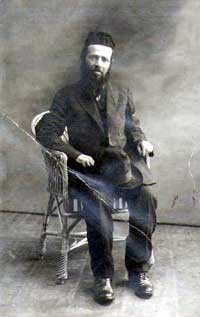
Return to Krosno's Table of
Contents
Return to Jasienica's Table of
Contents
Virtually all of the Feit families who immigrated to the United States since the mid-1880s from Austria /Poland are Jewish and originated from about 73 villages and towns in the southeastern corner of Poland. Most of these villages are clustered around Brzozow, Sanok, and Krosno and extend northward for about 60 miles along the River San – including Przemysl (near the border with Ukraine), Lezajsk, Rudnik, Nisko, Tarnobrzeg, Rozwadow and Radomysl. – to where it meets the River Wisla at the former northern border of the Austrian province of Galicia. Other Feits branches stem from Rymanow and Jasienica Rosielna.
Galician Jews adopted fixed hereditary surnames after the 1787 law of Kaiser Joseph II. Based on data extracted from hundreds of documents and databases, marriage and death certificates, naturalization records and information from Feit descendants, I have been creating family trees and searching for common ancestors to link together as many branches as possible. With a focus on older generations, my file now contains more than 8,000 individuals, with many name duplications, in 380 unconnected branches. The earliest known birth date is 1800 (Jacob Feit) and more than 1,500 individuals have known or estimated birth dates before 1900. Additional clues from descendants and Polish records are needed to merge more branches.
Two FEIT Family Tree Project reports are available upon request. The database contains more than 1,200 different surnames. A FEIT Family Photo Album was also created.
For more information, please email me by
clicking my name Bette Stoop Mas.
December 2013
Return to Krosno's Table of
Contents
Return to Jasienica's Table of
Contents
I visited Jasienica about six weeks ago. My husband Zeev Etra, is the great grandson of Natan Feit who is listed in the 1929 Business Directory. My father in law's father (Wolf Etra) died in Rymanow when my father in law was three months old and his mother Reisel nee Feit, went back home to Jasienica and helped run the family grain business.
Yehoshua lived in Jasienica until he was taken to Cracow, Plazow, Auschwitz, Dachau etc.He was in his twenties when the war broke out. After the war he was in a DP camp near Frankfurt and in 1947 arrived after internment in Cyprus, to Palestine.
My husband and I spent a weekend in Cracow and then drove to the Krosno area to see the places where Yehoshua had spent his childhood and youth. All our information for Jasienica was the number of house 351.
First we tried to find the site of the cemetery. People were most helpful. There is indeed nothing there except for a rectangular square with a plaque, on one corner the remains of a Jewish headstone. It seemed that there had been a memorial ceremony or something because we saw a wreath and a churchlike candle, not a Yizkor light. We said Tehillim and I left earth that I had brought from Israel. Afterwards we saw a sign with a map that showed the former Jewish sites. (That's how we understood it). We went looking for house no. 351 and eventually were directed to it. I cannot say for certain that that was the house. Yehoshua says the house looks familiar in our photos, but our description as to its location is not exactly as he remembers it. He says is house was near the square.
We tried looking for the market square but it didn't seem to exist! There was a public library situated in beautiful grassland park by the stream/river Rosiela and I was drawn to this building but there was nobody around to ask. By then it was late and pouring with rain. We left Jasienica feeling very frustrated, slept in Krosno and in the morning decided to return. Again I felt drawn to this building. We walked around and couldn't see anything.. We got into the car feeling very dejected when suddenly I saw what could only be the pillars of a synagogue in the grassland not far from the library. (The library was closed both times we were there). We scouted round the area and indeed, there was a hidden sign that said that this was where the synagogue was. When we showed the pictures to Yehoshua he recognized the pillars and told us that the Synagogue had been situated near the square. Obviously, all that beautiful grassland is where the square had once been.
Editor's Note, Sept 2009: We are fortunate to have a local expert in Jewish History, Piotr, who has written: "Unfortunately, this is a mistake. What Mrs Etra saw was the remains of the mansion of the local squire to whom Jasienica belonged before WWII. The last squire to own Jasienica was Count Wysocki, and it was the remains of his mansion that Mrs Etra mistook for the remains of the synogogue. Nr 351, that local people directed her to does not correspond to the 351 from before the war. The sad truth is that most of the Jewish town had been destroyed by the nazis, and only few buildings remained till the present day."
I took a picture of the school and Yehoshua recognized it immediately as the place he had learned till the age of 14. In the afternoons, he had Jewish studies in the Heider and the Kloiz.
Today, Jasienica looks like a prosperous agricultural community. The rolling hills, cultivated land and the beautiful lush greens of summer make it look very attractive. From Jasienica we went on to Rymanow and to Dukla.
I just felt that it would be right to inform you of our visit. Shana Tova. Daliah Maurer Etra
Return to Krosno's Table of
Contents
Return to Jasienica's Table of Contents
On May 1, 2004, I left Los Angeles, for a trip that began in
Poland, and continued to other parts of Eastern Europe over
the course of a month. It began in Warsaw, paying homage to
the Holocaust victims with visits to the site of the former
ghetto, the Jewish cemetery, Pawaik Prison, and other
important memorials, most notably Treblinka. 
I then set off for Krakow and from there hired an excellent guide, Artur Davidson, based in Krakow, who agreed to help me over the course of two days, to find the birth records of my grand parents. Both were born in 1873, Ray Weiser Feit, in Tarnow and Benjamin Feit, either in Tarnow or Jasienica-Rosielna. Both great-grandparents, Leibish Feit and Ester Eiss Feit, were born in Jasienica-Rosielna and I very much wanted to go there. Our first stop was the Tarnow Archives where I found the birth records of my paternal grandmother, and her parents, which was thrilling. In Tarnow, they actually let me go through the original records from 1873 and that was like going back in time, seeing the beautiful manuscript of the rabbis and their different writing styles.
We then went to the State Archives in Rzeszow, the Research Centre for History of the Jews from Galicia, (www.rzeszow.ap.gov.pl) and met with Dr. Grzegorz Zamoyski who was extremely kind and helpful; however, he doesn't speak English so a translator (Artur) was definitely necessary. He said the records for my great grandparents, born in Jasienica-Rosielna, in were in that town so off we went, only to be told by the head of the Records Office that they were not there.
Artur wasn't giving up easily and went to see the Mayor down
the hall, Marek Cwiakala Wojt, who was extremely welcoming and
anxious to help us in any way he could. He thought the records
might be in the Lvov Archives. He then escorted us to the
Memorial 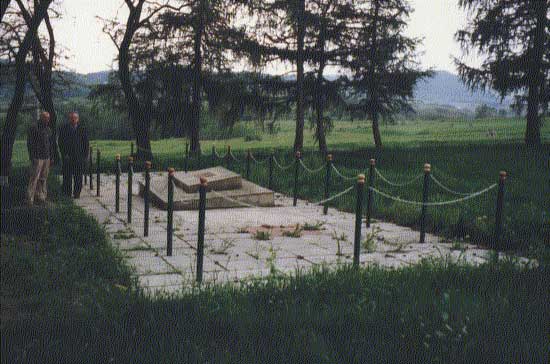 erected in 1967 to
the Jews of Jasienica Rosielna who died in the Holocaust
between 1939 and 1942. The Memorial was built at the
initiation of the Town Council at the time and was
re-furbished just a few years ago.
erected in 1967 to
the Jews of Jasienica Rosielna who died in the Holocaust
between 1939 and 1942. The Memorial was built at the
initiation of the Town Council at the time and was
re-furbished just a few years ago.
In the left hand corner of the memorial photograph above, is the Mayor of Jasienica, Marek Cwiakala Wojt and our guide Artur Davidson from Crakow.
The memorial, a simple plaque that lies flat on the ground,
is at the site of what was the Jewish
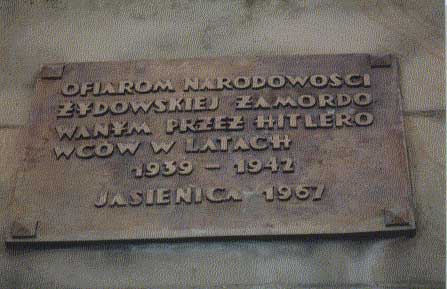 cemetery where, in
August, 1942, all the Jewish women, children and old people
were rounded up, taken to the cemetery site, summarily shot in
a mass grave. The area where they stood is cordoned off to
convey the size of site and is considered hallowed ground. The
cemetery is beyond it, only a green field with no stones, no
indication that it had been a cemetery.
cemetery where, in
August, 1942, all the Jewish women, children and old people
were rounded up, taken to the cemetery site, summarily shot in
a mass grave. The area where they stood is cordoned off to
convey the size of site and is considered hallowed ground. The
cemetery is beyond it, only a green field with no stones, no
indication that it had been a cemetery.
Prior to the war's outbreak, there were two major property owners in Jasienica Rosielna, the Catholic Church and Count Visotsky. The Count's son is still alive, living in Crakow and wrote a book about his family and the town. Jews also owned land and today there are some descendants who are trying to re-claim their property, making for some anxious feelings in this peaceful town.
Visually, Jasienica-Rosielna is a pastoral town, with lush farmland and broad vistas of green. It was a grey day when we were there but the beauty of the area was hard to camouflage. There are about 1100 people living in the town.
The Mayor telephoned several old people in town, trying to
get them to talk with us. I was hoping that someone might
remember my great-grandparents who were killed by the Nazis,
most likely at the site of the memorial. He took us to 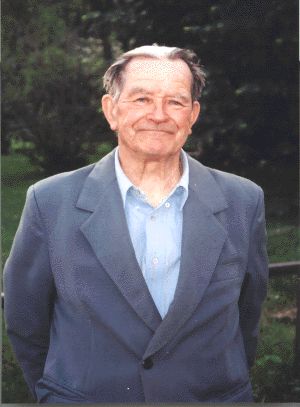 the home
of Mr. Kazimierz Walczak, an 81 year old Pole with a
very lucid memory and, inviting us into his home for coffee
and cookies, more than willing to talk to us.
the home
of Mr. Kazimierz Walczak, an 81 year old Pole with a
very lucid memory and, inviting us into his home for coffee
and cookies, more than willing to talk to us.
He had no recollection of my family name but he had a lot to say and we sat there riveted for almost three hours. He recalled his childhood, having Jewish friends he played with and who taught him some Yiddish. He was sometimes invited for their holidays and his family sometimes helped them in their preparations. He recalled being given matzah to eat and remembered many names of the Jewish holidays. He recalled the weekly market where Jews sold their wares.
His father was head of the local post office before World War
I, knew Morse Code, and was educated compared to most in the
town. His father was in the uprising, fighting with Pilduski,
a great Polish hero and after the war, couldn't get his former
job back. So he became a delivery man and worked for Jews,
transporting their products by carriage-shoes, hats-all over
the region, Sanok, Krosno. When he was very young, his father
sometimes took him along. He would watch his father bartering
with Jewish business associates and they always smacked their
hands together when they made a deal. He recalled that all
different types of Jews lived in Jasienica-Rosielna, Orthodox,
those who "ate sausage" and also Communists. 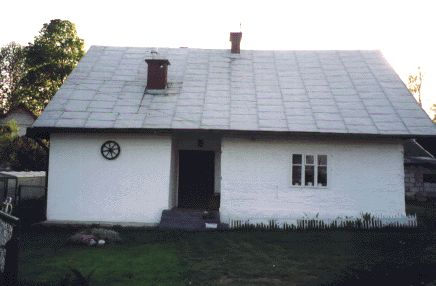 (The photograph on
the left is a former Jewish Inn in Yashnitza).
(The photograph on
the left is a former Jewish Inn in Yashnitza).
Kazimierz Walczak was16 years old when the Nazis invaded on September 9th, 1939, with armies coming from Slovakia. They took people from the synagogues into forced labor. They were forced to make boats for the invasion of the Soviet Union. There was a Nazi School for officers in the town.
His father was fearful of being taken away since he had worked with and had a good relationship with the Jews. A man who ran Count Visotsky's business had a German wife and they were sent by the Nazis to spy on the townspeople. This man, Maternoffsky, began to rule the local population for the Nazis.
Jewish families were hidden in cellars, and some survived the war. Some escaped into the woods and some were massacred in the cemetery. A Ukrainian division of soldiers shot them. Some people paid the Nazis to prolong their lives but they didn't always live up to their bargain. The Nazis took everything from the Polish farmers without giving them monetary payment, milk, wheat, meat and they had monthly quotas to meet. Their payment was only 1 liter of vodka. They were given soap by the Nazis and they found human hairs in the soap. He learned from those who escaped about what was going on in Auschwitz and how they made the soap. He told the story of a man who knew his sister had been taken to Auschwitz and he went there looking for her. He was shown all the women and he recognized her. He asked to take her place in the camp and they released her. He lived through the war but while in the camp had the horrible job of working in the gas chambers.
In 1941, our host, Kazimierz, was sent to a labor camp, Visnowa, near Rzeszow, along with all the locals, including Jews, who could work. They were building a tunnel for a train, the Cieszyna Tunnel, designed by an Italian. A Jewish physician working in the labor camp, told them that the meat in the soup was human meat and they believed it because of the taste and that the vegetables contained were ones the Poles would only feed to animals. My guide said that he had heard that before, Nazis using human meat in food for prisoners. Kazimierz was there for three months but then escaped with four other men, one of whom was shot. He spent the rest of the war hiding in a small village near Krakow. Because of his escape, his father was imprisoned.
Upon finishing his story, he put on his "Sunday best" and
took us on a tour of the town. 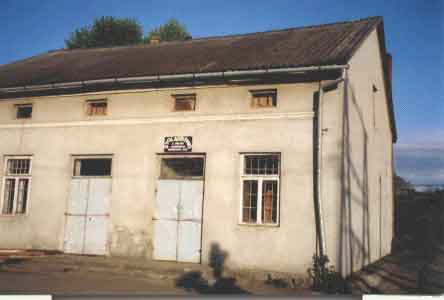 He first pointed out where the Jewish bakery
used to be on the main street of town (photograph right), then
the tailor (photograph below), next door, then several homes
owned by Jews, and as we walked along the main street, came to
the site of what used to be a large matzah factory, now a
parking lot. According to Kazimierz, they even exported to the
United States.
He first pointed out where the Jewish bakery
used to be on the main street of town (photograph right), then
the tailor (photograph below), next door, then several homes
owned by Jews, and as we walked along the main street, came to
the site of what used to be a large matzah factory, now a
parking lot. According to Kazimierz, they even exported to the
United States.
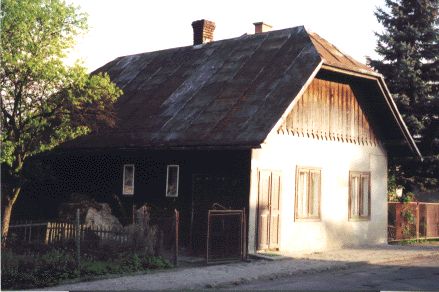 There used to be two synagogues in town, one made of wood, the
other concrete, and showed us the site of one.
There used to be two synagogues in town, one made of wood, the
other concrete, and showed us the site of one.
It was a very moving experience hearing his story and I know that he wanted to talk even more. No one listens very much to old people recalling their past, and although some memories are painful, they were part of his history and we wanted to hear it. It was our history too. --- Barbara Goldberg, Los Angeles California, June 2004 To email Barbara, click on her name.
Addendum April 2007 from Barbara: THE FOUR "LEO'S OF
JASIENICA-ROSIELNA" I am writing about four men I know
very little about. They were all named Leo and they were
boyhood friends who grew up in Jasienica-Rosielna in Poland.
All of them were shipped off to Germany to work as slave labor
for the Nazis. All of them were in various concentrations
camps and survived, settling in Brooklyn, New York.
One of them, Leo Feit, was my great-uncle. I never knew him,
nor did my father speak of him when I was a child. He was the
last of our family to leave Poland and he was an only child, a
man who never married or had children of his own. His father's
name was Israel, my grandfather's brother. The others named
"Leo" that I have limited or no information on were: 1. Leo
(Gidalya) Strasfeld married Shirley ????. They had five
children, David, and lived in Brooklyn. 2. Leo Shachner
married Mary ??? 3. Leo Jamel ??? Does anyone know who they
are? Barbara Goldberg,
Los Angeles California,April 2007. To email Barbara, click on
her name.
Return to Jasienica's Table of Contents
As reported by the US Commission in 1992, the town of Jasienica has fewer than 5000 inhabitants (no Jews). In 1921 there were 479 Jews living there.
The cemetery is located 1 km north of the village center; it was used by Orthodox Jews. It is in a rural area, on the crown of a hill, isolated; no marker, wall, fence or gate. It is reached by crossing private property. It is 0.1 hectare in size and there are no gravestones visible, however it does contain a special memorial monument to Holocaust victims. The present owner is unknown. It is now used as a Jewish cemetery visited rarely only by private visitors. Properties adjacent to the cemetery are agricultural. The cemetery is known to have been vandalized during WWII. There is presently no maintenance.
Hello Phyllis,
We just returned from our trip to Poland; we went with
organized tour of about 30 people, most of the time we were in
the Krakow area. My husband and I both have our roots in
Galicia. After the tour we hired a driver to take us to
Jasienica and the surrounding villages.
I was especially interested in finding the mass grave in the
jewish cemetery as I know many of my family were killed there.
I had a driver who can speak Polish and English. I found the
cemetery and the monument that the Polish government erected.
Also  there is a new Matzavah erected for the PARNES
family mentioning Mrs Parnes who was the daughter of the
Stropgever Rebbi, Rabbi HALBERSTAM, and including all the Jews
of the town.
there is a new Matzavah erected for the PARNES
family mentioning Mrs Parnes who was the daughter of the
Stropgever Rebbi, Rabbi HALBERSTAM, and including all the Jews
of the town.
I'm curious about who put the new Matzava.
There was just empty space and tall grass in the cemetery.
It was not hard to find, my driver had GPS and the we asked a
passing car who pointed us in the right direction. My
grandmother, my aunts and their children and my sister were
murdered in that place.
My mother's family name was BALSER; my grandmother was NAGEL
from Krosno. 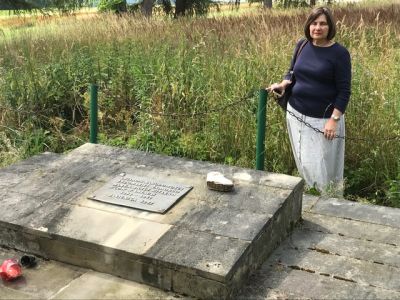
I did not see any main street or town square. The homes and
farm land around looked well cared for. The view around the
town was beautiful,the hills and agriculture were very scenic.
I was surprised by that, I guess I had Anitevka in my mind.
Here is the list of immigrants from Jasienica, who arrived at Ellis Island from 1892 through 1924; I am sure there are others, but this is what i was able to cull using stevemorse.org's gold query form.
If you want to see a list of immigrants who came to New York from any Shtetl during the period of greatest Jewish immigrantion, the directions are below.
It is relatively easy to do the query using Steve Morse’s wonderful web page on JewishGen: www.jewishgen.org/databases/EIDB . Here are the steps:
Certainly we would hope that if anyone hires a researcher or gets records from this town, they would share that with everyone. Email me information by clicking on my name. Jeff
The following men declared their birth in Jasienica in the 1942 draft (source: Ancestry.com)
The following was taken from "The Virtual Shtetl" a Polish site dedicated to Jewish History; you can see the full site at http://www.sztetl.org.pl/en/article/jasienica-rosielna/26,archives/2470,regional-museum-in-jasienica-rosielna/. If you use Chrome as an Internet Browser, you can easily get the majority of this site translated immediately.
"It is assumed that Jews lived in Jasienica Rosielna as early as the village was granted town rights. In 1765, Jewish population of the village was estimated at 58. At that time they belonged to Rymanowski kehilla. In 1835, 214 Jews lived in the area of local Roman Catholic Parish. In 1785, there were 115 Jews in Jasienica. As early as the 19th century Jews had their own Jewish Religious Congregation whose members, among other worshippers, were from Domaradz. There were also a synagogue and a cemetery. In 1870, the population of the Jewish Community in Jasienica was listed at 870. It had an above mentioned synagogue, school and two rabbis. Ten years later the total number of Jews in this region was 600 of the 1379 inhabitants.
In 1900, the population of the Jewish Community was counted as being 1118. Josef Gelerentner was the rabbi. Later, notwithstanding the growing number of inhabitants of Jasienica which reached as many as 2090, Jewish population was decreasing and in 1921 there were only 479 Jews in the region. Population of the Jewish Community increased to 520 people until 1939.
Wolf Eichenstein was the rabbi. In 1929 there were 7 licenses out of which 5 were in Jewish hands. In the years 1939-1940 Nazis repatriated some Jews from Krosno to Jasienica. In 1942, the Jewish ghetto was established. Approximately 40 Jews were building for some time a fortification near Dynow.
In the ghetto there were also Jews from Blizne, Domaradz, Golcowa, Gwoznica, Orzechówka, Wesola i Wola Jasienicka. Altogether, 1,500 people lived there. Destruction of the ghetto began on 11 August 1942, when Nazis from Krosno alongside Ukrainian Police ringed Jasienica in the morning. Jews were chased out of their homes and 7 of them were killed during this campaign.After the selection was done, a group of strong and healthy men were taken by cars to the railway station in Krosno from where they were further transported to Krakow-Podgorze. Young Jewish females and older children were taken by cars to the railway station Iwonicz. The elderly, women and children were shot dead at the local kirkut (Jewish cemetery). Infants and little children were killed by grabbing them by their legs and smashing their skulls against the trees. Executions lasted from 10:00 to 17:00, including a one-hour long break in between. In all, 624 people lost their lives. Their bodies were buried in a mass grave.
Jasienica's synagogue was totally destroyed by the Nazis in
their campaign. The Jewish cemetery, which was situated half a
kilometer from the former market square 0.1 hectare in size,
was vandalised and there are no macevas visible nowadays."
Return to Jasienica's Table of Contents
I originally found this list on the Yad Vashem website...it was secured from the Polish Archive "Zydowsi Instytut History" in Warsaw. In 2018 I found the original list in the JDC archives.It is a list of flour recipients dated January 13, 1941. I have alphabetized the list of 95 names
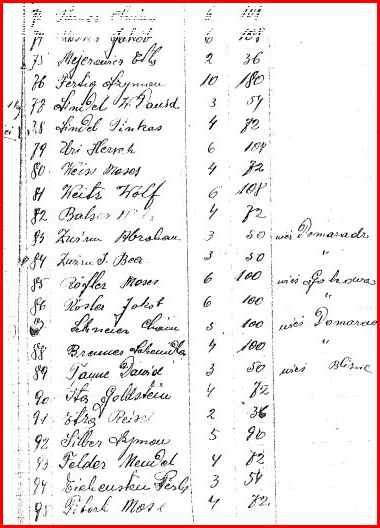
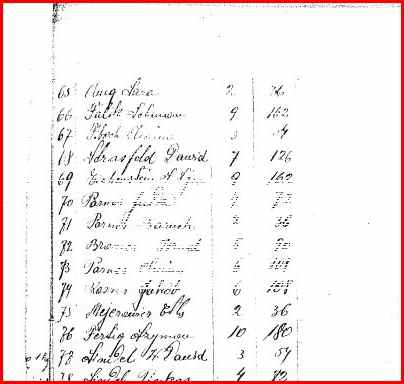
Return to Krosno's Table of Contents
Return to Jasienica's Table of Contents